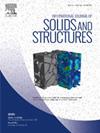Inverse design of short-range order arrangement via neural network
IF 3.4
3区 工程技术
Q1 MECHANICS
International Journal of Solids and Structures
Pub Date : 2024-11-29
DOI:10.1016/j.ijsolstr.2024.113175
引用次数: 0
Abstract
Short-range order (SRO) plays a critical role in the mechanical behavior of metallic alloys. The arrangement of atoms at short ranges significantly impacts how the material responds to external forces. Nevertheless, the mechanics of these phenomena remain poorly understood. The identification of SRO in experiments is constrained by the low resolution of intensity distribution and the limitations associated with the direct observation of atomic arrangements in the lattice within the SRO domains. On the other hand, modeling the mechanical properties of short-range-ordered alloys is challenged by computationally expensive density functional theory (DFT)-based Monte Carlo (MC) simulations required to achieve the SRO structure dictated by energy minimization. This study aims to replace these expensive simulations with a trained machine learning (ML) model that yields accurate energy values for a given atomic structure. Further, we train an inverse model to determine the atomic configuration corresponding to the given SRO parameter. We propose a data-driven approach to map out the SRO directly to the atomic arrangements, combining ab initio calculations and a Neural Network (NN) model. We perform DFT-based MC simulations for Ni-V alloys in a wide range of solute compositions. Then, forward and inverse NN models are trained to map the SRO parameters into atomic arrangements or vice-versa. We predict the critical resolved shear stress (CRSS) for slip for all the studied configurations encompassing random and SRO structures and discuss the effect of SRO on the flow stress. The proposed ML methodology provides atomic arrangements from target order parameters with high accuracy, thereby eliminating the need for expensive simulations, and it advances the understanding of SRO at the atomistic scale.
求助全文
约1分钟内获得全文
求助全文
来源期刊
CiteScore
6.70
自引率
8.30%
发文量
405
审稿时长
70 days
期刊介绍:
The International Journal of Solids and Structures has as its objective the publication and dissemination of original research in Mechanics of Solids and Structures as a field of Applied Science and Engineering. It fosters thus the exchange of ideas among workers in different parts of the world and also among workers who emphasize different aspects of the foundations and applications of the field.
Standing as it does at the cross-roads of Materials Science, Life Sciences, Mathematics, Physics and Engineering Design, the Mechanics of Solids and Structures is experiencing considerable growth as a result of recent technological advances. The Journal, by providing an international medium of communication, is encouraging this growth and is encompassing all aspects of the field from the more classical problems of structural analysis to mechanics of solids continually interacting with other media and including fracture, flow, wave propagation, heat transfer, thermal effects in solids, optimum design methods, model analysis, structural topology and numerical techniques. Interest extends to both inorganic and organic solids and structures.

 求助内容:
求助内容: 应助结果提醒方式:
应助结果提醒方式:


